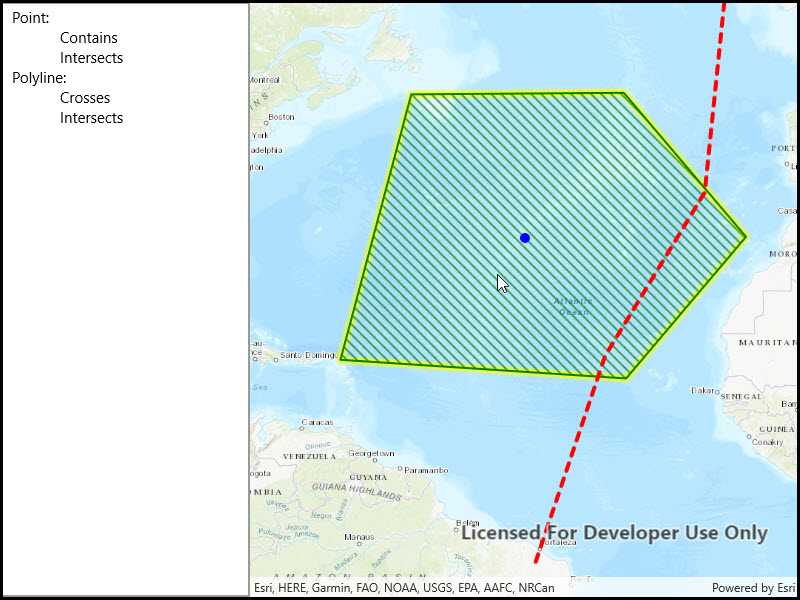Determine spatial relationships between two geometries.

Use case
In case of a natural disaster, emergency services can represent the affected areas using polygons. By determining the spatial relationships between these and any other existing features such as populated areas, infrastructure, or natural resources, it is possible to quickly determine which of the existing features might be affected or is in further danger, helping to assess risk and define further action.
How to use the sample
Select one of the three graphics. The tree view will list the relationships the selected graphic has to the other graphic geometries.
How it works
- Get the geometry from two different graphics. In this example the geometry of the selected graphic is compared to the geometry of each unselected graphic.
- Use the methods in
GeometryEngineto check the relationship between the geometries, e.g.contains,disjoint,intersects, etc. If the method returnstrue, the relationship exists.
Relevant API
- Geometry
- GeometryEngine
- GeometryEngine.Contains
- GeometryEngine.Crosses
- GeometryEngine.Disjoint
- GeometryEngine.Intersects
- GeometryEngine.Overlaps
- GeometryEngine.Touches
- GeometryEngine.Within
- GeometryType
- Graphic
- Point
- Polygon
- Polyline
Tags
geometries, relationship, spatial analysis
Sample Code
// Copyright 2018 Esri.
//
// Licensed under the Apache License, Version 2.0 (the "License"); you may not use this file except in compliance with the License.
// You may obtain a copy of the License at: http://www.apache.org/licenses/LICENSE-2.0
//
// Unless required by applicable law or agreed to in writing, software distributed under the License is distributed on an
// "AS IS" BASIS, WITHOUT WARRANTIES OR CONDITIONS OF ANY KIND, either express or implied. See the License for the specific
// language governing permissions and limitations under the License.
using Esri.ArcGISRuntime.Data;
using Esri.ArcGISRuntime.Geometry;
using Esri.ArcGISRuntime.Mapping;
using Esri.ArcGISRuntime.Symbology;
using Esri.ArcGISRuntime.UI;
using Esri.ArcGISRuntime.UI.Controls;
using System;
using System.Collections.Generic;
using System.Drawing;
using System.Linq;
namespace ArcGIS.WinUI.Samples.SpatialRelationships
{
[ArcGIS.Samples.Shared.Attributes.Sample(
name: "Spatial relationships",
category: "Geometry",
description: "Determine spatial relationships between two geometries.",
instructions: "Select one of the three graphics. The tree view will list the relationships the selected graphic has to the other graphic geometries.",
tags: new[] { "geometries", "relationship", "spatial analysis" })]
public partial class SpatialRelationships
{
// References to the graphics and graphics overlay
private GraphicsOverlay _graphicsOverlay;
private Graphic _polygonGraphic;
private Graphic _polylineGraphic;
private Graphic _pointGraphic;
public SpatialRelationships()
{
InitializeComponent();
// Setup the control references and execute initialization
Initialize();
}
private void Initialize()
{
// Configure the basemap
MyMapView.Map = new Map(BasemapStyle.ArcGISTopographic);
// Create the graphics overlay
_graphicsOverlay = new GraphicsOverlay();
// Add the overlay to the MapView
MyMapView.GraphicsOverlays.Add(_graphicsOverlay);
// Set the selection color
MyMapView.SelectionProperties.Color = Color.Yellow;
// Create the point collection that defines the polygon
PointCollection polygonPoints = new PointCollection(SpatialReferences.WebMercator)
{
new MapPoint(-5991501.677830, 5599295.131468),
new MapPoint(-6928550.398185, 2087936.739807),
new MapPoint(-3149463.800709, 1840803.011362),
new MapPoint(-1563689.043184, 3714900.452072),
new MapPoint(-3180355.516764, 5619889.608838)
};
// Create the polygon
Polygon polygonGeometry = new Polygon(polygonPoints);
// Define the symbology of the polygon
SimpleLineSymbol polygonOutlineSymbol = new SimpleLineSymbol(SimpleLineSymbolStyle.Solid, System.Drawing.Color.Green, 2);
SimpleFillSymbol polygonFillSymbol = new SimpleFillSymbol(SimpleFillSymbolStyle.ForwardDiagonal, System.Drawing.Color.Green, polygonOutlineSymbol);
// Create the polygon graphic and add it to the graphics overlay
_polygonGraphic = new Graphic(polygonGeometry, polygonFillSymbol);
_graphicsOverlay.Graphics.Add(_polygonGraphic);
// Create the point collection that defines the polyline
PointCollection polylinePoints = new PointCollection(SpatialReferences.WebMercator)
{
new MapPoint(-4354240.726880, -609939.795721),
new MapPoint(-3427489.245210, 2139422.933233),
new MapPoint(-2109442.693501, 4301843.057130),
new MapPoint(-1810822.771630, 7205664.366363)
};
// Create the polyline
Polyline polylineGeometry = new Polyline(polylinePoints);
// Create the polyline graphic and add it to the graphics overlay
_polylineGraphic = new Graphic(polylineGeometry, new SimpleLineSymbol(SimpleLineSymbolStyle.Dash, System.Drawing.Color.Red, 4));
_graphicsOverlay.Graphics.Add(_polylineGraphic);
// Create the point geometry that defines the point graphic
MapPoint pointGeometry = new MapPoint(-4487263.495911, 3699176.480377, SpatialReferences.WebMercator);
// Define the symbology for the point
SimpleMarkerSymbol locationMarker = new SimpleMarkerSymbol(SimpleMarkerSymbolStyle.Circle, System.Drawing.Color.Blue, 10);
// Create the point graphic and add it to the graphics overlay
_pointGraphic = new Graphic(pointGeometry, locationMarker);
_graphicsOverlay.Graphics.Add(_pointGraphic);
// Listen for taps; the spatial relationships will be updated in the handler
MyMapView.GeoViewTapped += MapViewTapped;
// Set the viewpoint to center on the point
MyMapView.SetViewpointCenterAsync(pointGeometry, 200000000);
}
private async void MapViewTapped(object sender, GeoViewInputEventArgs geoViewInputEventArgs)
{
// Identify the tapped graphics
IdentifyGraphicsOverlayResult result = null;
try
{
result = await MyMapView.IdentifyGraphicsOverlayAsync(_graphicsOverlay, geoViewInputEventArgs.Position, 1, false);
}
catch (Exception e)
{
await new MessageDialog2(e.ToString(), "Error").ShowAsync();
}
// Return if there are no results
if (result == null || result.Graphics.Count < 1)
{
return;
}
// Get the first identified graphic
Graphic identifiedGraphic = result.Graphics.First();
// Clear any existing selection, then select the tapped graphic
_graphicsOverlay.ClearSelection();
identifiedGraphic.IsSelected = true;
// Get the selected graphic's geometry
Geometry selectedGeometry = identifiedGraphic.Geometry;
// Perform the calculation and show the results
ResultTextbox.Text = GetOutputText(selectedGeometry);
}
private string GetOutputText(Geometry selectedGeometry)
{
string output = "";
// Get the relationships
List<SpatialRelationship> polygonRelationships = GetSpatialRelationships(selectedGeometry, _polygonGraphic.Geometry);
List<SpatialRelationship> polylineRelationships = GetSpatialRelationships(selectedGeometry, _polylineGraphic.Geometry);
List<SpatialRelationship> pointRelationships = GetSpatialRelationships(selectedGeometry, _pointGraphic.Geometry);
// Add the point relationships to the output
if (selectedGeometry.GeometryType != GeometryType.Point)
{
output += "Point:\n";
foreach (SpatialRelationship relationship in pointRelationships)
{
output += $"\t{relationship}\n";
}
}
// Add the polygon relationships to the output
if (selectedGeometry.GeometryType != GeometryType.Polygon)
{
output += "Polygon:\n";
foreach (SpatialRelationship relationship in polygonRelationships)
{
output += $"\t{relationship}\n";
}
}
// Add the polyline relationships to the output
if (selectedGeometry.GeometryType != GeometryType.Polyline)
{
output += "Polyline:\n";
foreach (SpatialRelationship relationship in polylineRelationships)
{
output += $"\t{relationship}\n";
}
}
return output;
}
/// <summary>
/// Returns a list of spatial relationships between two geometries
/// </summary>
/// <param name="a">The 'a' in "a contains b"</param>
/// <param name="b">The 'b' in "a contains b"</param>
/// <returns>A list of spatial relationships that are true for a and b.</returns>
private static List<SpatialRelationship> GetSpatialRelationships(Geometry a, Geometry b)
{
List<SpatialRelationship> relationships = new List<SpatialRelationship>();
if (a.Crosses(b)) { relationships.Add(SpatialRelationship.Crosses); }
if (a.Contains(b)) { relationships.Add(SpatialRelationship.Contains); }
if (a.Disjoint(b)) { relationships.Add(SpatialRelationship.Disjoint); }
if (a.Intersects(b)) { relationships.Add(SpatialRelationship.Intersects); }
if (a.Overlaps(b)) { relationships.Add(SpatialRelationship.Overlaps); }
if (a.Touches(b)) { relationships.Add(SpatialRelationship.Touches); }
if (a.Within(b)) { relationships.Add(SpatialRelationship.Within); }
return relationships;
}
}
}